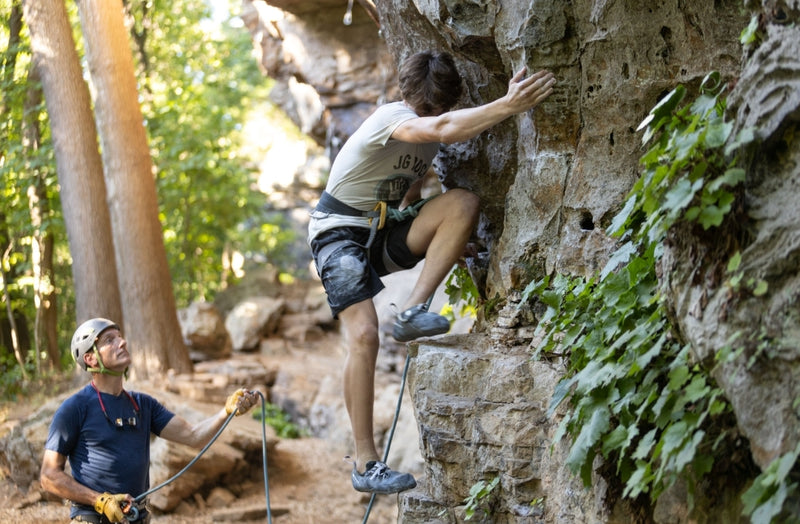GRIP GOALS, STRONG CLIMBS: TACKLING BLISTERS AND CALLOUSES IN YOUR CLIMBING, NINJA WARRIOR, OR FITNESS JOURNEY
Hey rock climbers, ninja warriors, and any other fitness enthusiasts! No matter what sport you do, or if you're just diving into a new upper body workout routine, one thing's for sure: callouses leading to flappers, splits with cracks in the grooves of your fingers, can be your worst nightmare when training. But, don’t worry, I’ve got some tips to share with you on how to keep those hands smooth and blister-free while sending your projects, crushing the course, or killing your workouts.
Tip #1: Avoiding Flappers in the First Place
When doing moves like laches in ninja warrior, dynos in climbing, or snatches and cleans in weightlifting, it’s common to use performance chalk. Chalk, made from magnesium carbonate, is the stuff that dries your hands and makes grabbing onto bars or climbing holds easier. With too much chalk and no moisture, this causes too high of a friction on your hands, leading you to get a flapper. On the contrary, using no chalk can be tricky or dangerous if your hands get too sweaty while performing these types of activities. I’ve experienced a situation myself where I was not using chalk when trying to max out on a lache. I peeled off backwards with my slippery hands, and strained my wrist. I couldn’t train for a couple of weeks. When it comes to chalking up, there is a sweet spot, not too much, but enough to give you a great grip. Using moderate amounts of chalk, your hands still have grip on the surface, still allowing your hands to move around a bar or climbing hold, but not too much chalk that can lead to a flapper. In addition, there are also two different forms of chalk that you can use when training; powdered chalk or liquid chalk. It depends which one you like more. Check out my previous blog post Types of Chalk where I go into more details about the different types of chalk and the pros and cons of each one of them.
Tip #2: Moisturize Like There's No Tomorrow
Dry, cracked skin is a prime breeding ground for callouses. Before you hit the hay, apply some moisturizer. Keeping your skin moisturized can help prevent calluses from forming. Also, make it a habit to moisturize your hands daily at night before going to bed. Trust me, your hands will thank you for the hydration boost. I use the brand Gold Bond Healing that you can get at any grocery story. Keep in mind though, do not apply moisturizer right before training. Your hands will be too slippery.
Tip #3: Invest in Quality Hand Creams
Not all hand creams are created equal. Look for creams with ingredients like shea butter, vitamin E, or lanolin. These ingredients work wonders in keeping your skin resilient against the wear and tear of intense workouts. Using a protective balm can protect your callused hands from forming blisters. They are also helpful in healing already ripped, dry or cracked skin, and they speed up your callus or blister recovery process.
Here are some of the creams I use:
Rino Repair - Great for healing bad skin or big open flappers.
Rino Split - For healing the splits in my fingers.
Rino Performance - I use this one the days before training if my hands are in good condition, to keep them dry. I’ve noticed less hand damage whenever I use it the night before a hard climbing or ninja training. All these Rino products are available at Amazon.
Climb Skin - If my skin is bad, the morning of a training day I use Climb Skin paste to help skin condition throughout the day. Also available at Amazon.
Bag Balm - I only use this at night if my hands are in really bad shape, like bleeding, many cuts, and cracks in fingers. This balm is very good and helps heal your damaged hands quickly, but it’s very oily and sticky, so definitely use it only at night before going to bed. Also, I suggest wearing gloves because this cream can smear all over your pillow and sheets. You can get Bag Balm at a local grocery store or Walgreens.
Tip #4: File Down Calluses
If you already have calluses on your hands, it’s important to file them down regularly to prevent them from getting too thick and causing blisters. Use a pumice stone or callus file to gently file down the calluses. It helps prevent them from getting too thick and causing blisters.
Tip #5: Shave Your Calluses
Calluses are the body's natural defense mechanism. They form as a result of repeated friction or pressure, like rock climbing, ninja, weightlifting, or intense workouts. When the skin experiences consistent rubbing or stress, it thickens and toughens up to protect the underlying layers from damage. Essentially, calluses are the body's way of adapting to repetitive strain.
However, the irony lies in the fact that, despite their protective role, calluses can contribute to the formation of blisters.
Blisters occur when the outer layer of skin separates from the underlying layers due to intense pressure or friction. This separation creates a pocket that fills with fluid, acting as a cushion between the layers to minimize damage. So, while calluses toughen the skin to prevent damage, they can contribute to the development of blisters when subjected to extreme or prolonged stress.
Shaving your calluses can reduce their thickness and prevent them from becoming overly hard or painful. It can also help minimize the risk of blisters. However, it's important to approach callus shaving cautiously, ensuring the procedure is done with proper tools, hygiene, and a focus on maintaining the skin's integrity. Also, do not shave your skin the same day you’re training. This procedure needs to be done the day you’re off, your resting day. Additionaly, before start shaving your calluses, if you’re not sure about the procedure, consult with your doctor or a dermatologist for advice.
Before you start shaving your calluses, wash your hands thoroughly with soap and warm water to soften your calluses. Make sure your hands are well dry so the razor doesn’t slip too much whenever you’re trying to cut the dead skin off your hands. Also, disinfect the callus shaver with disinfecting alcohol. Make sure everything is sanitized to prevent infection.
Have the blade from the shaver parallel with the surface of your hands and go really slow and make gentle, controlled strokes over the callused area. Do not press too hard or shave too deep to avoid injury. Be patient. If you start feeling pain while shaving, stop immediately. Pain may indicate that you are shaving too aggressively.
Once you've completed the shaving, rinse your hands with clean water and hydrogen peroxide to disinfect. After disinfecting, use a moisturizer on your hands to help keep the skin hydrated. Also, make sure to disinfect your callus shaver with disinfecting alcohol before storing it away.
You don’t need to shave too often. Once a month should be enough. Also, keep an eye on the shaved area for any signs of infection, such as redness, swelling, or increased pain. If you notice any concerning symptoms, go to the doctor.
Tip #6: Treat Torn Calluses Right Away
If you do get a blister or tear in your callus, it’s important to treat it right away to prevent infection. Clean the area with soap and water, apply an antibiotic ointment, and cover it with a bandage.
Tip #8: Gradually Increase Intensity
If you're diving into rock climbing, ninja warrior, or a new workout routine, start slow. Gradually increase the intensity to give your hands time to build resilience and avoid extreme soreness.
Tip #12: Alternate Workout Days
Give your hands some breathing space. If you're into intense climbing, ninja, or upper body workouts, consider alternating days to let your hands recover. This not only prevents overuse injuries but also allows your skin to heal and toughen up gradually.
Tip #9: Using Proper Hand Technique
In rock climbing, ninja warrior, weightlifting, or any upper body workout that requires grip, technique matters! A lot. Adjust your grip If you’re experiencing calluses or blisters on your hands. It may be because you’re gripping the equipment too tightly. Try adjusting your grip to reduce the amount of pressure on your hands, specifically your upper palm where flappers are most common.
Tip #10: Strategic Tape Wrapping
Ever considered strategic tape wrapping? Check out some Youtube videos of professional Athletic Trainers or Physical Therapists to learn the proper technique to wrap your hands to prevent flappers or cover them up while healing temporarily when training to prevent further damage.
Tip #11: Hand Maintenance Post-Workout
Just finished a killer workout or a tough climbing sesh? Post-session hand maintenance is crucial. Rinse your hands with cool water to remove sweat, chalk, and dirt. Pat them dry, and apply a moisturizer and hand creams. Consistent post-workout care is your secret weapon against callouses gone rogue.
Tip #13: Take Breaks
If you’re doing an activity that requires repetitive motions, such as laches, weightlifting, or pull-ups/muscle-ups, taking breaks from that specific activity can help reduce the amount of pressure on your skin and prevent calluses from forming.
Alright! Hope these tips help you keep healthy hands during your workouts! Lather on that moisturizer, train in moderation, and let's crush it! Your hands deserve some love in this thrilling fitness adventure.


